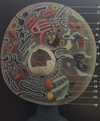animal cell Flashcards
(16 cards)
1

Lysosome
membrane bounded vesicles that contain enzymes involved in the digestion of foreign elements. Conditions that result in the release of these enzymes into the cytoplasm may result into cell death.
2

Ribosomes
Particles composed of RNA and protein that are involved with messenger RNA in the synthesis of proteins.
3

Golgi Body
A system of stacked, membrane-bounded sacs. The Golgi is involved in processing macromolecules for secretion and delivery to other components of the cell.
4

Centrioles
A short cylindrical array of nine triplet microtubules. Found in animal cells and cells of most eukaryotic organisms that produce flagellate cells.
5

Centrosome
Region close to the nucleus in eukaryotic cells. It is an area involved in the development of microtubules (often referred to as a microtubule organizing center) that are necessary for cell movements, e.g. the mitotic spindle. Each pole of the spindle of a dividing nucleus would have a centrosome. In animal cells and most plants and fungi with motile cells, the centrosome contains a pair of centrioles.
6

Mitochondria
Organelles present in eukaryotic cells and bounded by two membranes. They are often referred to as the power plants of cells as they are the site of aerobic respiration that combines oxygen with food molecules to generate ATP, an important energy containing molecule. Like chloroplasts, mitochondria usually contain circular DNA (similar to the organization of DNA in bacterial cells) that codes for some of the mitochondrial proteins. Ribosomes in mitochondria are smaller than those in the cytosol and of the same size as bacterial rihosomes.
7

Cytoplasm/Cytosol
cytoplasm- All the material and organelles inside the plasma membrane and outside of the nucleus.
Cytosol- Everything in the cytoplasm other than the membrane-bounded organelles.
8

Rough ER
synthesizes proteins
9

smooth ER
lipid synthesis
10

Nuclear Envelope
The double membrane structure that surrounds the nucleus and separates it from the rest of the cytoplasm. It has nuclear pores that allow for communication between the nucleus and the cytoplasm.
11

Nuclear Pores
Openings in the nuclear envelope that allow for communication between the nucleus and the cytoplasm.
12

Nucleus
This is the most conspicuous organelle in most cells. It is separated from the cytoplasm by the nuclear envelope that consists of an inner and outer membrane layer. Nuclear pores in the envelope allow the nucleus to communicate with the cytoplasm. The nucleus contains most of the cell’s genetic material in the DNA that makes up the chromatin fibers of the chromosomes. The nucleolus is in the nucleus and it is the site at which ribosomes are assembled.
13

Nucleolus
Site in the nucleus where ribosomes are synthesized.
14

Chromatin
Complex of the DNA and proteins in the nucleus of a eukaryotic cell.
15

Plasma Membrane (Cell Membrane)
The outer boundary of the cell; also called the cell membrane. A sheet of lipid molecules (bilayer) with proteins embedded in it. The plasma membrane controls movement of materials into and out of the cytoplasm.
red line

Vacuoles
Membrane-bounded structures in the cytoplasm that may contain enzymes, crystals and dissolved materials. Animal cells have small vacuoles whereas plant cells characteristically have large vacuoles. Plant vacuoles may store waste materials but also help to maintain the shape of plants. If large amounts of water are removed from the vacuoles, wilting occurs.


